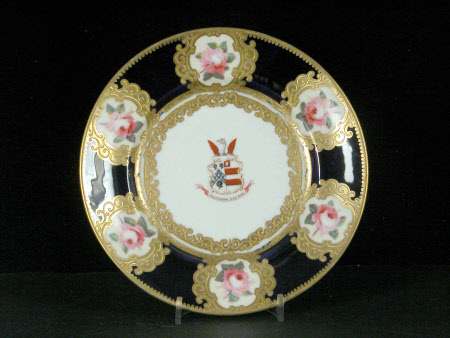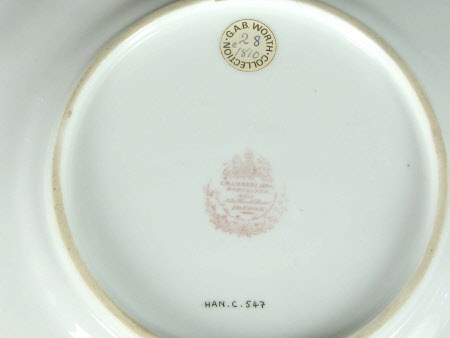Plate
Chamberlain and Company
Category
Ceramics
Date
circa 1820
Materials
Porcelain, paint, gilt
Measurements
223 mm (Diameter)
Place of origin
Worcester
Order this imageCollection
Hanbury Hall, Worcestershire
NT 413725
Summary
An armorial plate, by Chamberlain & Co., Worcester, circa 1820. The ivory ground painted with the impaled arms of Hullock, 'argent, a chevron vair argent and azure betweem three Moors' heads sable' and Martin 'argent, two bars gules, and on a canton of the second, an escutcheon argent'. The rim cobalt blue and gilt, and with ivory reserves painted with pink roses and green leaves. John Hullock (1767-1829) married Mary Martin (d. 1852) on 20 September 1794 in Stokesley, Yorkshire. Hullock was an English lawyer, judge and baron of the exchequer. He was knighted in 1823.
Full description
Note on Heraldry: The head of a black person – sometimes crowned, sometimes ‘wreathed’ about the head – appears frequently as a motif (or charge) in medieval European heraldry. In the language of heraldry, the person depicted is described (or blazoned) as a ‘maure’, ‘moor’, ‘blackmoor’ or ‘blackamoor’, and the motif as ‘a maure’s head’ or ‘a moor’s head’, and so on. The term ‘maure’ derives from the Greek work ‘mauros’ meaning ‘black’ or ‘very dark’ and, in the medieval and early modern periods, was an ill-defined stereotype applied to Muslims of the Islamic Iberian Peninsula and North Africa. Usage developed to conflate Muslims of any ethnicity with black Sub-Saharan Africans. The image of the ‘moor’ or ‘blackamoor’ in European heraldry is itself usually stereotyped. Precisely when and where this motif was adopted as an heraldic charge is unknown, but the earliest example is thought to date from 11th century Italy. Its origins may lie in the invasion of Spain and Portugal in 711 by Africa and Arab Muslim forces. In Western Europe, the device may have referred to the black Egyptian St. Maurice, the patron saint of the Holy Roman Empire from the beginning of the 10th century, or to denote participation in the Crusades. Sometimes, in England, the device is used in what are known as ‘canting’ arms, and are incorporated into the arms of a family called ‘More’ or ‘More’, as a pun on their name. Several National Trust properties were, at one time in their history, owned by families whose coats of arms and/or crests incorporated ‘a moor’s head’ as an heraldic charge, and so it appears on objects which survive in National Trust collections. The arms of the Bankes family of Kingston Lacy, for instance, granted in 1613, included the crest ‘a moor’s head, full-faced, couped at the shoulders proper, on the head a cap of maintenance gules, turned up ermine, adorned with a crescent, issuant therefrom a fleur-de-lis or’. ‘Moors’ heads’ also featured in the arms of the Watt family, slave-traders and owners of several Jamaican plantations, who bought Speke Hall in 1795 and who set up their arms in stained glass in one of the windows there. The term ‘moor’ is now considered anachronistic, but it remains part of heraldry’s descriptive vocabulary. It is used here in its historical and heraldic context.
Marks and inscriptions
Underside: [in iron-red] CHAMBERLAIN WORCESTER...LONDON Underside: G.A.B. WORTH COLLECTION, 28 c. 1810
Makers and roles
Chamberlain and Company, maker

